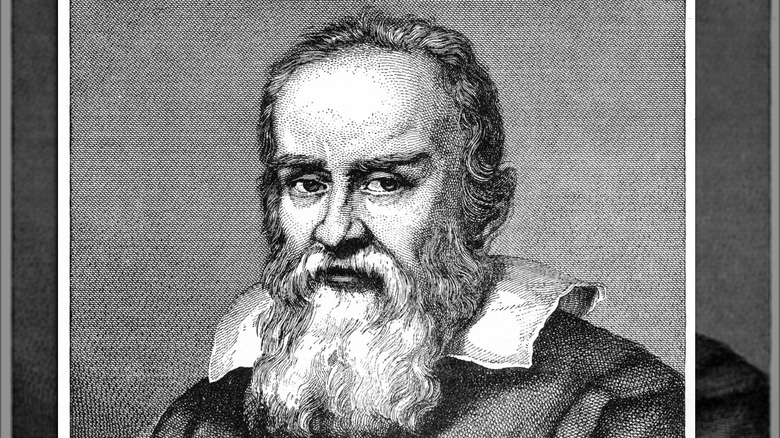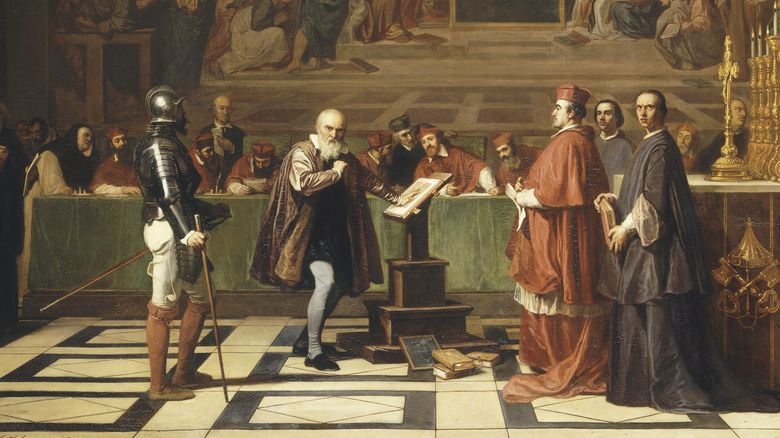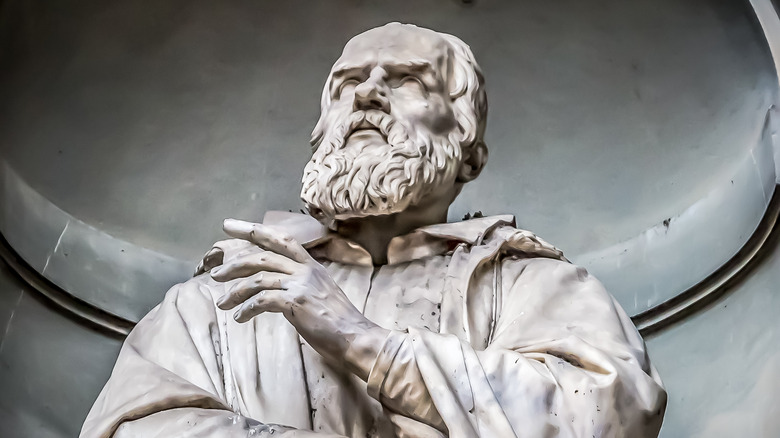Why Galileo Galilei Was Sentenced To Life In Prison
Imagine getting put on trial over a scientific theory. That's what happened to Italian astronomer Galileo Galilei in 1633. Back then, a person could be persecuted for (and even put to death) for contradicting religious doctrine. In the case of Galileo, he faced punishment for his views about the universe. What was at the center of the universe — Earth or the sun? The Catholic Church believed the Bible said that all the other planets revolved around Earth and to oppose this belief was an act of heresy. But Galilei was a man of science and believed that the scientific evidence supported the opposing theory (via Nature).
In 1543, a Polish astronomer named Nicolaus Copernicus published his theory about the planets orbiting the sun in the book "On the Revolutions of the Heavenly Spheres." The theory of a sun-centered universe became known as the Copernican model. Around this time in Italy, Pope Paul III established the Congregation of the Inquisition to assist in the battle against Protestants and others who went against the Church and its teachings (via History). Elsewhere, Galileo studied the heavens with a telescope of his own creation and made discoveries that challenged the Church's view of the universe.
Galileo Galilei was tried for heresy
In 1613, Galileo Galilei wrote a letter to Benedetto Castelli discussing certain passages from the Bible and how they didn't fit the Copernican model of the universe (via Britannica). A Dominican friar named Niccolò Lorini got his hands on a copy of this letter and sent it to the Inquisition two years later (via Nature). Around the same time, the Inquisition officials had decided that the Copernican theory was heretical, and even books on the topic were banned. Galileo received a scolding from a cardinal about his support of this theory and was told to drop the issue entirely.
For more than a decade, Galileo remained quiet about his thoughts on the universe. But he couldn't hold his tongue forever. In 1632, he published "Dialogue Concerning the Two Chief World Systems," in which he offers his own analysis of the Church's model and the Copernican model. This book quickly drew the attention of Inquisition officials. They formed a commission to study Galileo's latest work and concluded that he should be put on trial for heresy.
Galileo traveled to Rome in 1633 to face the Inquisition. According to History, Father Vincenzo Maculani de Firenzuola began questioning the famed scientist, seeking to obtain a confession. But Galileo would not admit that he did anything wrong. The Inquisition reached a plea deal of sorts with him (via the University of California Los Angeles). Ultimately, Galileo had to acknowledge some wrongdoing in how he presented the Copernican model to receive a lesser punishment.
Galileo Galilei spent the rest of his life under house arrest
On June 22, 1633, Galileo Galilei was found guilty by the Church of having "rendered yourself suspected by this Holy Office of heresy" (via History). He received a life sentence for this suspicion of heresy charge. Had he been convicted of actual heresy, Galileo might have suffered a different fate. Notably, the Inquisition found mathematician Giordano Bruno, a friar, guilty of heresy in 1600 (via Nature). He was burned at the stake for his crimes against the Church.
Galileo's time behind bars was brief, however. His sentence was quickly changed to house arrest, and he spent the rest of his days at his home in Acretri, Villa Il Gioiello (via History). Galileo wasn't publishing any new works while stuck at home, and yet he was still able to write his final work, "Discourses and Mathematical Demonstrations Concerning Two New Sciences," which was snuck out of Italy and published in Holland in 1638. Galileo died in 1642, and more than 300 years after his death, the Church finally officially declared that he was correct in his belief that the sun is the center of the universe (via New Scientist).


